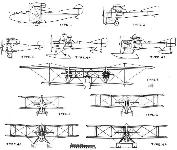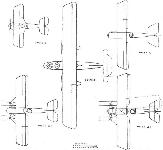J.Bruce British Aeroplanes 1914-1918 (Putnam)
Sage Type 3
THE Sage Type 3 was designed in 1916 at the request of the Air Department of the Admiralty for a primary trainer. The principal requirements were for robustness and a low landing speed.
The Sage Type 3 emerged in January, 1917, as a two-bay biplane powered by the 75 h.p. Rolls-Royce Hawk engine. Six experimental machines were ordered, and there was the prospect of substantial production to follow. The machine was entirely conventional in appearance and construction. The undercarriage was somewhat reminiscent of that of the Armstrong Whitworth F.K.8, but two small wheels were fitted at the forward end of the horizontal skid.
The prototype, N. 5280, first flew on January 5th, 1917, and a large order for the type was placed by the Admiralty. Production had just begun when the Admiralty cancelled the contract and asked Sages to concentrate on the development of seaplanes.
The performance of the Type 3 was rather poor, even for a trainer. The prototype underwent some modification and was fitted with smaller vertical tail surfaces; the all-up weight was reduced somewhat and the maximum speed was increased by 4 m.p.h. In its modified form the machine was known as the Type 3b, and the original form was retrospectively re-designated Type 3a.
SPECIFICATION
Manufacturers: Frederick Sage & Co., Ltd., Peterborough.
Power: 75 h.p. Rolls-Royce Hawk.
Dimensions: Span: 34 ft 6 in. Length: 32 ft 10 in. Height: 10 ft 9 in. Chord: 4 ft 9 in. Gap: 5 ft. Stagger: 11-8 in. Dihedral: 2 30'. Incidence: upper 3, lower 5. Span of tail: 11 ft 4 in. Airscrew diameter: 8 ft.
Areas: Wings: 330 sq ft. Ailerons: each 18 sq ft, total 72 sq ft. Tailplane: 26 sq ft. Elevators: 24 sq ft. Fin: 4 sq ft. Rudder: 10 sq ft.
Weights: Empty: 1,390 lb. Loaded: Type 3a, 2,064 lb; Type 3b, 1,980 lb.
Performance: Type 3a. Maximum speed at ground level: 72 m.p.h. Climb to 5,000 ft: 20 min. Ceiling: 9,000 ft. Endurance: 4 hours. Type 3b. Maximum speed at ground level: 76 m.p.h. Ceiling: 9,000 ft. Endurance: 4 hours.
Tankage: Petrol: 26 gallons. Oil: 4 gallons.
Serial Number: N.5280.
H.King Armament of British Aircraft (Putnam)
Type 3. A carrier for four 20-lb bombs appears to have been fitted beneath the fuselage of this 1917 trainer, though the makers quoted the military load as 64 lb. It may be conjectured that anti-submarine operation with a 65-lb bomb was envisaged.
Jane's All The World Aircraft 1919
The Sage No. 3 was designed in the autumn of 1916 as a primary training machine and was fitted with dual control with a full cut-out gear in the instructor's cockpit. The undercarriage is of the oleo-pneumatic type and has a pair of small wheels mounted on the front Vee in addition to the landing wheels.
Specification.
Type of machine Biplane.
Name or type No. of machine Sage 3.
Purpose for which intended Training.
Span 34 ft. 6 in.
Gap, maximum and minimum 5 ft.
Overall length 26 ft 6 In.
Maximum height 10 ft. 9 In.
Chord 4 ft. 9 in.
Total surface of wings 330 sq. ft.
Span of tail 11 ft. 4 in.
Total area of tail 26 sq. ft
Area of elevators 24 sq. ft.
Area of rudder 10 sq. ft.
Area of fin 4 sq. ft.
Area of each aileron 18 sq.ft.
Total area of ailerons 72 sq. ft.
Maximum cross section of body 2 ft. 6 in. x 2 ft. 6 in.
Horizontal area of body 59 sq. ft.
Vertical area of body 78 sq. ft.
Engine type and h.p. 75 h.p. Rolls.
Airscrew diameter and pitch 8 ft. d. x 6 ft. 4 in. p.
Airscrew revs 1500 r.p.m.
Weight of machine empty 1390 lbs.
Load per sq. ft 6.25 lbs.
Weight per h.p. 27.5 lbs.
Tank capacity In hours 4 hours.
Tank capacity in gallons 26 gallons.
Performance.
Speed low down 72 m p.h.
Landing speed 38 m.p.h.
Climb.
To 5,000 feet 20 minutes.
Disposable load apart from fuel 119 lbs.
Total weight of machine loaded 2064 lbs.
Ceiling 9,500 ft.
Журнал Flight
Flight, July 24, 1919.
"MILESTONES"
THE SAGE MACHINES
The Sage Type 3
The next Sage machine to be designed was a two-seater tractor intended for training purposes. It was, therefore, designed with a view to good visibility, ease of handling, and low landing speed. As the machine was intended for instruction purposes she was fitted with dual control. The most unusual feature of the Type 3 is the undercarriage, which as will be seen is fitted with an extra pair of wheels in front to prevent overturning when in the hands of a novice.





